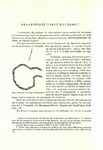Θαλαμοειδής τάφος Καρπάθου (Πίν. 12-26)

Öffnen
Autor
Χαριτωνίδης, Σεραφείμ Ι.Datum
1963Language
el
Verlag
Υπηρεσία Αρχαιοτήτων και Αναστηλώσεως
Schlagwort
Bibliographic details
Αρχαιολογικόν Δελτίον, 1961/62, Τόμος 17, Μελέται/Μέρος Α’, 32-76.
Access
free
Journal title
Αρχαιολογικόν Δελτίον
Zusammenfassung
In this article ( pp. 32-76 ) the author describes and comments on the contents
of a chamber tomb found by chance in the vicinity of Pigadhia, the chief community
of Carpathos, one of the southernmost islands of the Dodecanese.
The finds include over ninety vases and a small hoard of bronze weapons, as well as a pair of lead objects. Where its provenience is concerned, the pottery may
easily be distinguished into two main classes, one LM IIIA, related to the eastern
workshops of Crete, and another LH IIIA (-early IIIB), with a dominant number of
Rhodomycenaean affinities. Between these two main classes the author believes that
he can identify a third from a local workshop (to which he also attributes earlier finds
from the island) sharing common features with both Minoan and Mycenaean pottery.
This fact-easily explained by the geographical position of the island midway between
East Crete and Rhodes ( representing respectively the Minoan and Mycenaean
centers of manufacture readily accessible to the Carpathians)—implies the independent
position of the island, which continued to have free intercourse with East Crete
and at the same time was in close contact with the Mycenaean world, at least
through the intermediary of Rhodes.
